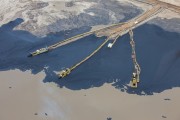The accumulation of more than 1,000,000,000,000 (1 trillion) litres of fluid oilsands tailings in Northern Alberta – enough sludge to fill 400,000 olympic swimming pools – is the result of five decades of negligence and engineering failures.
Bitumen typically constitutes only 10% of each shovel-load of oilsands, and the oilsands industry uses a lot of water to process that material. While industry recycles as much of that water as it can, there is a limit to how much water can be reused. Continuously recycling the water used to process bitumen leads to high concentrations of salt, sulphate, chloride, and ammonia in the water. The contaminated water becomes increasingly useless for bitumen processing and causes scaling and corrosion in infrastructure, raising concerns of potentially chronic toxicity in reclaimed landscapes.
These persistent problems have brought fluid tailings back to the forefront as more mature mines prepare to close operations within the next 15-20 years. Kicking the can down the road is simply no longer an option, as the practical need to reclaim these mine sites is right around the corner. So, you may ask, how was the situation allowed to get this bad?
Strike one; no regulations at all for the first 40 years
At the outset of commercial oilsands mining in 1967, no one realized suspended clay particles within fluid tailings would take hundreds of years to naturally settle to the bottom of the ponds. In 1973, Alberta Environment published a series of reports about the Athabasca oilsands that recognized the nascent ponds were already a serious problem. The reports saw industry's technical inability to treat tailings as “the most imminent environmental constraint to the future expansion” of oilsands mining.
Despite early knowledge of the severe and largely intractable environmental problems posed by tailings ponds, cleaning them up remained essentially voluntary until 2009. Under the auspices of this extremely permissive management approach, oilsands mining companies consistently failed to meet even their own unambitious commitments made in project applications.
Strike two; a failed first attempt at regulation in 2009
In response to mounting public concern, precipitated in part by the infamous “Syncrude ducks” incident when 1,600 waterfowl died after landing on Syncrude’s Aurora tailings lake, the Energy Resources Conservation Board (ERCB) produced standards for tailings management in 2009 with Directive 074: Tailings Performance Criteria and Requirements for Oil Sands Mining Schemes. It held oilsands mining companies responsible for capturing and drying up to 50% of all new fluid tailings by 2013.
Directive 074 was a failure. Within months of its introduction the ERCB accepted tailings plans that didn’t comply. Soon after, the regulator quietly released its annual tailings management reports, revealing that every single company had failed to meet both the standards of Directive 074 and the weaker targets they had individually negotiated with the regulator.
There were no consequences for this non-compliance. The ERCB attributed the en-masse failure to technological problems the industry had encountered when attempting to implement the new standards. So, contrary to promises from the government in 2009 that tailings ponds would soon vanish entirely, the toxic legacy for Alberta has continued to grow exponentially. In 2006 fluid tailings ponds and dykes could have covered two Sylvan Lakes; today they could cover five.
Strike three? Last chance for action in 2017
In March 2015, the Government of Alberta released the Tailings Management Framework for the Mineable Athabasca Oil Sands (TMF). For the first time in Alberta’s history there was a policy that set targets for fluid tailings produced and accrued between 1967 and 2015.
In August 2016, Directive 085:Fluid Tailings Management for Oil Sands Mining Projects was introduced by the Alberta Energy Regulator (AER) to enforce the TMF. Unlike the strict targets set by Directive 074, this is flexible and permits companies to propose their own criteria for tailings treatment. What the AER will accept in terms of which criteria and technologies constitute sufficient “treatment” remains to be seen. These decisions will comprise the fulcrum of the Directive's effectiveness, because while no tailings treatment technologies have been confirmed to work reliably in the long term and on a large scale, some have been demonstrated to be more effective than others in reclaiming tailings waste to a degree that can produce stable and productive final ecosystems.
The deadline for all current operators to submit a Tailings Management Plan in compliance with Directive 085 was November 1. With the Government of Alberta’s dismal track record at adequately managing oilsands tailings, it is imperative that all companies are held to the strict requirements of the directive and that enforcement mechanisms for non-compliance be clearly prescribed, sufficiently stringent, and universally compulsory.
In light of the Alberta Auditor General’s 2015 estimate that total reclamation liabilities for the Alberta oilsands mining sector now exceed $20 billion dollars, this is the last opportunity for our government to ensure that tailings ponds are finally cleaned up by the companies that created them. Otherwise, these enormous economic, social, and environmental costs will fall onto the shoulders of Alberta taxpayers in the very near future.
In my next blog, Will Alberta's oilsands finally be cleaned up?, I examine oilsands companies’ submissions under the TMF and assess whether tailings in Alberta will finally be regulated appropriately.
This is the second in a Pembina Institute series on the oilsands tailings issue. Read the first, Oilsands tailings back in the spotlight. For more information on tailings management in Alberta, please check out Pembina Institute's recent whitepaper on Directive 85, and Statements of Concern on industry's individual management plans.









